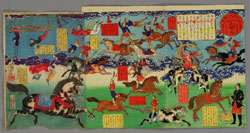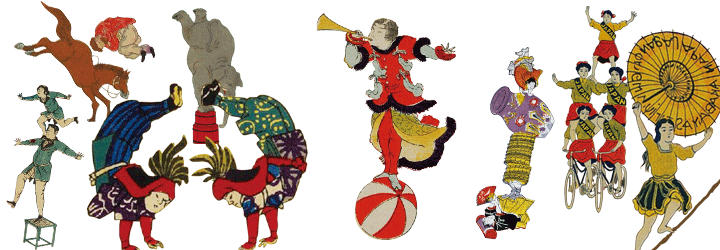Special Exhibition Amazing show tents in Japan


(Tokyo Meisho) Tokyo no Daiyurakuchi Asakusa Koen no Nigiwai
(Tokyo Landscapes: Crowds in the Sixth District of Asakusa Park, a major amusement park in Tokyo) (Property of the National Museum of Japanese History)
Gurashi (topics to attract people's attention) and barkers encourage visitors to enter the world of amazing shows and exhibits.
This section focuses on various performances by people, including incredibly high-skilled acrobatics, performances in show tents, in which performers freely breathe in and out fire, water, and other things, and kabuki- and historical-narrative-based nozoki karakuri (peep shows).

Furansu Daikyokuba (Surie Ichiza) (French Circus: Cirque Soulie) (Property of the National Museum of Ethnology)
II – 1: Acrobatics
The visitors will see the genealogy of the groups of acrobatic performers popular in the Edo and Meiji periods, details of their skills, activities of the acrobatic groups that introduced circus skills and techniques from outside Japan in the Meiji period and after, and acrobatic folk entertainment established as entertainment to be performed by themselves as a result of the performances spreading to various places.
II – 2: Welcome to the show tent
This section features what a show tent where various performances were shown looked like, including actual human performers freely breathing out fire and swallowing and spitting out various things.
II – 3: Plays
This section focuses on plays based on the world of stories that are already widely known through various genres such as kabuki plays, puppet shows and other performances, historical narratives and rakugo entertainment, comic and romantic novels, and other literature.

Tokyo Meisho no Uchi Asakusa-ku Kinryuzan Sensoji Keidai Ichiran (Tokyo Landscapes: A bird's-eye view of the premises of Kinryuzan Sensoji Temple) (Property of the National Museum of Japanese History)
This section showcases nishikie (colored woodblock prints) and photos depicting the crowds and show tents in the entertainment areas of cities and premises of shrines and temples.
Here, visitors can see various exhibits of familiar things transformed into unexpected shapes, shapes that look more real than the real thing, animals of an unknown world, and strange items to stimulate and satisfy people's curiosity.

Konjaku Miken Seibutsu Mouko no Shinzu (Never Seen Before: True Picture of a Live Wild Tiger) (Property of the National Museum of Japanese History)
IV – 1: Crafts
The exhibits include various shapes created, using everyday familiar items as materials, other shapes created by assembling things in a witty manner, and items that cannot possibly move but have been made movable. Crafts creatively and elaborately made for shows are displayed.
IV – 2: Dolls
This section showcases doll shows depicting various scenes not viewable in real life, using dolls that look more real than real human beings to show fleeting expressions, fictional figures, historical figures, scenes of cruelty, and others.
IV – 3: Animals
The exhibits show how rare animals and birds brought from outside the country enjoyed popularity as the shows travelled around the country.
IV – 4: Exotic lands
This section shows how the image of exotic lands developed and became popular as one of the major themes of the various genres of the shows.

Denki Shokikai Kyomon Tenkan (Exhibition of Electrical Equipment) (Property of the National Museum of Japanese History)
This section shows the relationship between the shows that introduced new things from Europe and the U.S. since the Meiji period and the museums that have helped spread scientific knowledge and information and, moreover, the effect of these shows on plays, films, and other creative activities.






